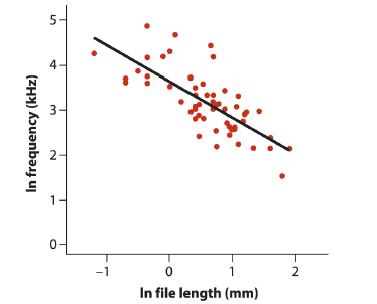Can the songs of extinct species be predicted? Gua et al. (2012) used measurements of living species
Question:
Can the songs of extinct species be predicted? Gua et al. (2012) used measurements of living species of katydid to predict the call frequency, or “pitch,” of the extinct Archaboilus musicus based on a 165- million-year-old fossil. Male katydids call by stridulating—rubbing forewings together so that a scraper on one wing rubs against a “file” on the other. Call frequency is predicted by file length (see accompanying graph; the data are available at whitlockschluter3e.zoology.ubc.ca). File length of a single well-preserved fossil of the extinct Archaboilus musicus was 9.34 mm. What was its call frequency? A summary for log-transformed data is as follows:
n=58, ΣiXi=33.241, ΣiYi=183.936, ΣiXi2=42.615, ΣiYi2=609.994, ΣiXiYi=86.720.

a. Calculate the regression line from the summary numbers provided. Assume for the purpose of this exercise that the data points are independent.
b. On the basis of this regression, what is the predicted log-transformed call frequency of Archaboilus musicus? The log file length for this species is 2.23.
c. What is the most-plausible range of values for the stridulation frequency of the 165-million-yearold katydid? Give the appropriate 95% confidence interval or prediction interval to determine this.
d. Calls with a frequency above about 20 kHz [or ln(frequency) of about 3.0] are ultrasonic and inaudible by most humans. How confident can we be that the calls of Archaboilus musicus were audible to humans? Answer based on your confidence or prediction interval in part (c).
Step by Step Answer:

The Analysis Of Biological Data
ISBN: 9781319226237
3rd Edition
Authors: Michael C. Whitlock, Dolph Schluter





